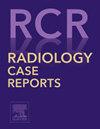Pathologies in a preterm infant exposed to methamphetamine in utero: Case report and literature review
Q4 Medicine
引用次数: 0
Abstract
Methamphetamine (M-AMP) use among women of childbearing age is a growing global concern Herein we present an unusual clinical presentation in a preterm infant born to a mother who used M-AMP during pregnancy. A 26-year-old woman, with no prenatal care, presented to the emergency department with aggressive behavior and visible skin wounds led to suspicion of substance abuse. Urine analysis confirmed high levels of amphetamines (2000 ng/mL). The infant was delivered by cesarean section at 30 + 5/7 weeks, with a birth weight of 1580 grams. The infant, admitted to the NICU due to respiratory distress and prematurity, initially required nasal CPAP and exhibited transient tachypnea. Enteral feeding was initiated at 24 hours of life but was halted due to feeding intolerance. Once the baby's symptoms subsided, enteral feeding was gradually reintroduced and slowly increased. The infant successfully transitioned to full enteral feeding by the 15th postnatal day. Cranial ultrasound revealed hyperechoic areas in the right parietal lobe, and subsequent MRI showed millimetric T1 hyperintense areas, indicative of parenchymal microischemia. Preterm infants exposed to methamphetamine in utero may not show typical withdrawal symptoms. Diagnostic challenges arise from prematurity, with significant impacts on brain development and potential neurocognitive deficits.
早产儿在子宫内暴露于甲基苯丙胺的病理:病例报告和文献复习
甲基苯丙胺(M-AMP)在育龄妇女中的使用是一个日益增长的全球关注。在这里,我们提出了一个不寻常的临床表现,早产婴儿的母亲谁在怀孕期间使用M-AMP。一名26岁的女性,在没有产前护理的情况下,因攻击性行为和明显的皮肤伤口被送到急诊室,导致怀疑滥用药物。尿液分析证实安非他明含量高(2000纳克/毫升)。患儿于30 + 5/7周剖宫产,出生体重1580克。该婴儿因呼吸窘迫和早产入住NICU,最初需要鼻腔CPAP,并表现出短暂性呼吸急促。24小时开始肠内喂养,但由于喂养不耐受而停止。一旦婴儿的症状消退,肠内喂养逐渐重新引入并缓慢增加。婴儿在出生后第15天成功过渡到完全肠内喂养。颅脑超声显示右侧顶叶高回声区,随后MRI显示毫米T1高回声区,提示实质微缺血。早产儿在子宫内接触甲基苯丙胺可能不会表现出典型的戒断症状。诊断挑战来自早产,对大脑发育和潜在的神经认知缺陷有重大影响。
本文章由计算机程序翻译,如有差异,请以英文原文为准。
求助全文
约1分钟内获得全文
求助全文
来源期刊

Radiology Case Reports
Medicine-Radiology, Nuclear Medicine and Imaging
CiteScore
1.10
自引率
0.00%
发文量
1074
审稿时长
30 days
期刊介绍:
The content of this journal is exclusively case reports that feature diagnostic imaging. Categories in which case reports can be placed include the musculoskeletal system, spine, central nervous system, head and neck, cardiovascular, chest, gastrointestinal, genitourinary, multisystem, pediatric, emergency, women''s imaging, oncologic, normal variants, medical devices, foreign bodies, interventional radiology, nuclear medicine, molecular imaging, ultrasonography, imaging artifacts, forensic, anthropological, and medical-legal. Articles must be well-documented and include a review of the appropriate literature.
 求助内容:
求助内容: 应助结果提醒方式:
应助结果提醒方式:


